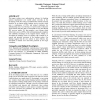Free Online Productivity Tools
i2Speak
i2Symbol
i2OCR
iTex2Img
iWeb2Print
iWeb2Shot
i2Type
iPdf2Split
iPdf2Merge
i2Bopomofo
i2Arabic
i2Style
i2Image
i2PDF
iLatex2Rtf
Sci2ools
SOUPS
2010
ACM
2010
ACM
Usably secure, low-cost authentication for mobile banking
This paper explores user authentication schemes for banking systems implemented over mobile phone networks in the developing world. We analyze an authentication scheme currently deployed by an Indian mobile banking service provider which uses a combination of PINs and printed codebooks for authenticating users. As a first step, we report security weaknesses in that scheme and show that it is susceptible to easy and efficient PIN recovery attacks. We then propose a new scheme which offers better secrecy of PINs, while still maintaining the simplicity and scalability advantages of the original scheme. Finally, we investigate the usability of the two schemes with a sample of 34 current and potential customers of the banking system. Our findings suggest that the new scheme is more efficient, less susceptible to human error and better preferred by the target consumers. Categories and Subject Descriptors D.4.6. [Security and Protection]: Authentication, Cryptographic controls. H.5.2 [User I...
Authentication Scheme | Banking System | Security Privacy | SOUPS 2010 | User Authentication Schemes |
| Added | 16 Aug 2010 |
| Updated | 16 Aug 2010 |
| Type | Conference |
| Year | 2010 |
| Where | SOUPS |
| Authors | Saurabh Panjwani, Edward Cutrell |
Comments (0)

